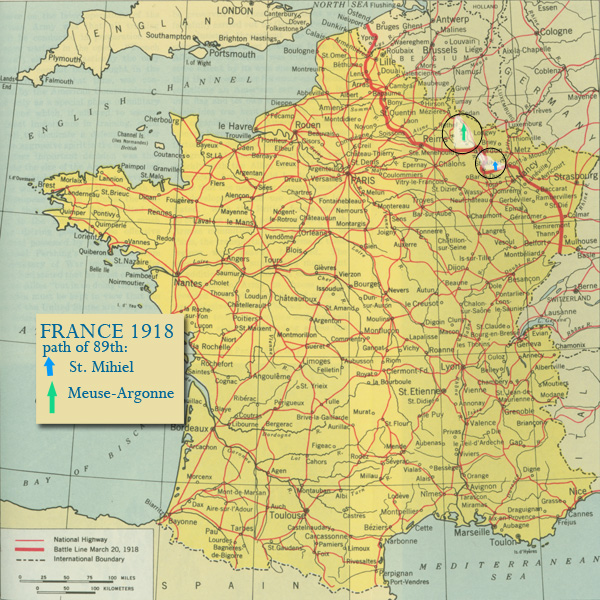
| Click on the thumbnail pictures below to change the main picture. | ||||||||||||
 |
||||||||||||
|
The Western Front
In Europe, World War I was essentially a line across France and into Brussels. A long bleeding gash of trench systems and barbed wire meant to catch your clothing and turn you into an easy target. The war began in 1914 and the Germans were beating the crap out of the French and British. Fast-forward to the Americans deciding they better get into the fray. General Pershing was assigned to put together the American Expeditionary Force. The U.S. Regular Army only amounted to 135,000 men at the time and, from his visit to the front in 1917, Pershing decided no less than 1,000,000 soldiers would be needed to overwhelm the Central Powers and win a decisive victory. The U.S. quickly and easily passed a selective service law and drafted every available man between the ages of 18 and 45. Most of these draftees received 6 months of training before shipping out. The Yanks are coming!... It will soon be over, over there.
The Americans didn't spread out among the French and British, but fought as an independent army under their own command. While some Regular Army divisions had been deployed earlier to give a morale boost to the Allies, the massive American offensive didn't begin until September of 1918 when the new divisions were in place. They chose the St. Mihiel region to start.
When you spot the St. Mihiel area on a map of France it looks so tiny, doesn't it? My little blue arrow shows the path of victory for the 89th. The white patch shows the full battlefield.
The European experience of WWI was an endless horror show. But for 1,400,000 Americans, the combat on the Western Front was only two months long. I would have never guessed that.
Timetable - 1918 (click on THUMBNAILS above to see the 89th Division troop movement)
It fascinates me to be able to see exactly (within a few miles) where an ancestor of mine stood during a dreadful/heroic time in history. Walter was attached to the 314th Engineers, 89th Division.
Late August, 1917 - June 20, 1918 Recruitment and training. At the age of 25, Walter was still living with his family on 1162 Aubert Avenue in St. Louis when he was inducted on April 29, 1918.* He trained for at Camp Funston, Kansas for considerably less time than the average of 6 months. Walt's younger brother Tab (Trevor) was inducted on May 27.** His 31-year-old brother Frank was inducted Jun 27.**
Jun 21 - Aug 9. Arrival in France, additional training and moving across to the front in the St. Mihiel region. Private Walter Price shipped out on June 12, 1918.*
Aug 10 - Sept 11. 89th is in sector, in the general vicinity of Limey and Marvoisin. Attached to the French Eighth Army (French XXXII Corps) till late August , then to the U.S. First Army (IV Corps). I guess there is no such thing as "quiet" on the front -- the 89th had 212 casualties during this month before formal combat operations began.
What does my grandfather do? As a combat engineer, his job is mobility and counter-mobility. In the heat of battle, the capacity to deliver firepower, troops and supplies to any part of the battlefield is crucial to success. Combat engineers use their skills to overcome all physical obstacles natural and man-made, ensuring that the troops can reach their targets and fight effectively. They employ a wide variety of equipment to help troops cross physical barriers.
"Counter-mobility" is the term used to describe efforts to hinder the enemy's movement. Engineers are trained to use explosive charges to create obstacles, crater roads and destroy bridges.
Sept 12 - 16. St. Mihiel offensive -- a surprise attack -- begins. The 89th is in battle, part of the main attack, in the general vicinity of Bois de Mort-Mare and Xammes, attached to the First Army and IV Corps. Despite their 833 casualties, the operation was a grand success and boosted the Allies' morale. The Americans were proven particularly good at penetrating the wretched barbed wire entanglements that the Germans were famous for. I wonder what role the engineers had in clearing the way.
Sept 17 - Oct 10. 89th is in sector, in the general vicinity of Xammes, attached to the same. 1351 casualties.
Oct 11 - 19. 89th moves to the Meuse-Argonne region, about 40 miles away, to join another major offensive had been launched on the night of Sept 25-26. They move into position to replaced divisions already worn out from battle.
Oct 20 - Nov 11. 89th is in battle, in the vicinity of Rémonville, Barricourt and Stenay, attached to the First Army, V Corps. 3864 casualities.
Nov 11. Armistice.
Nov 22. The 89th joins the Third Army and became part of the Army of Occupation. The weather is cold and rainy and in many places the roads were nearly impassable. Most transportation lines were completely destroyed. The troups have not stopped working since the fierce battle at Argonne. They are allowed to rest now till Dec 1.
Dec 1 - 21. 89th pushs into Germany and finally established headquarters in Kylburg, Germany.
Early 1919. There aren't enough ships to get everyone home. For those who are waiting, a vast school system is formed to teach virtually every subject taught in U.S. public schools. Soldiers are allowed leave to visit resorts in France and Germany. A great deal of entertainment is provided, including sports and games, culminating in the Inter-Allied Games near Paris in July 1919. Private Price arrived back in the United States on May 23, 1919, where he was honorably discharged.* His brothers arrived within days of him -- Tab on May 17 and Frank on May 28.**
*From
Walter's Army Card
located in the Missouri State Archives Soldiers Database: War of 1812 -
World War I
**Tab's
Army Card and Frank's
Army Card
2.21.05 (rev. 12.18.06)





